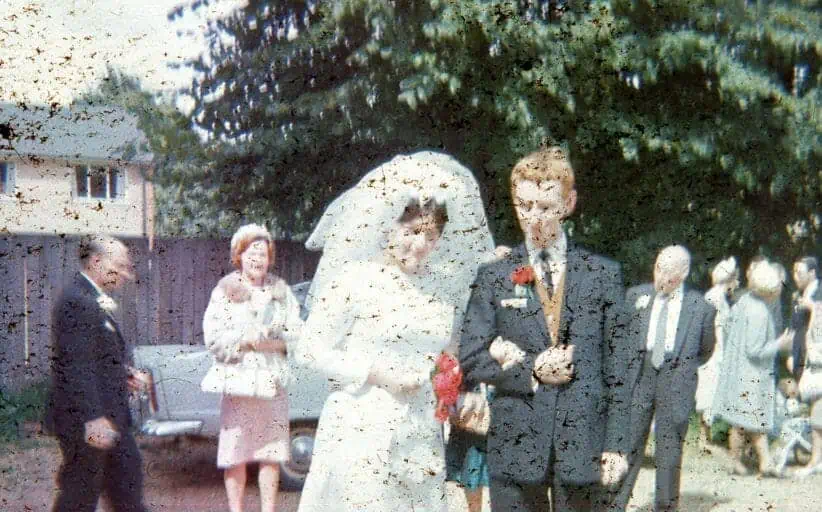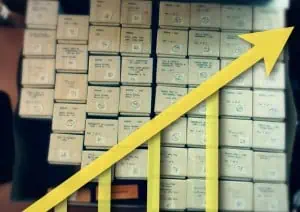A 70-Year-Old Silver Surfer Scans Her Entire Life!
Theresa Wentworth describes how she scanned her entire life, scanning in nearly ten thousand photographs over the course of several years.

I bought my first camera in 1960. Shortly after leaving school I took a job in a laboratory, working on photographic chemicals. I was so enthralled by the idea of photography that I spent my first paycheck on a Kodak Brownie 44A camera.
I explored my home district of south Hertfordshire in England on foot, taking pictures on 127 film. I developed the negatives myself in my bedroom, with the orange streetlight outside my window performing the duty of the traditional red darkroom light.
The photographic eye I developed in those early years stood me in good stead four years later when, in 1964, I took a long-distance train journey to the Holy Land. There I took several dozen photographs of a land that has endured much change and turmoil in subsequent years. That was a lot of photographs in those days.
Developing prints was expensive back then, so my pictures of the Holy Land and indeed almost all my other early pictures existed only as slides. Forty years after the trip, shortly after I had retired, my son Mark Wentworth exclaimed that it was a pity that pictures of such an extraordinary journey should languish in a box, unseen and practically unseeable: whoever heard of using a slide projector in the 21st century?

The Beginning of My Scanning Project
Being a man of action as well as words, my son Mark bought me a slide scanner and taught me how to use it. I scanned in the slides of the Holy Land without much difficulty. I was delighted to be able to view them on my computer with the same ease as I could view the digital photographs that I had started taking in 1999.

Thrilling though this experience was, it was only the start of a major retirement project. I went on to scan my entire life over the course of several years. I acquired an Epson scanner that could scan negatives and prints as well as slides and started to attack the project in rough chronological order.
The remainder of the slides came first. Then I started work on the prints in the photograph albums that I had lovingly curated over the decades. The physical albums had started to deteriorate to the extent that some of them were falling apart. Scanning the prints was an ideal way to remedy this. I also scanned in all the prints that had not made the cut for the photograph albums but I had kept nevertheless. I also spent several months scanning in approximately 4,000 negatives. All in all I must have scanned nearly ten thousand photographs in one form or another.
My son provided invaluable help. He later applied the skills we learned together to scan his own collection of 2,000 photos. (Click here to read about his entire scanning journey)

Not all of the images were in good condition. Some were in quite a poor state. This made me all the more glad that I was scanning them in: the digitised versions of the photographs would not deteriorate any further. I used IrfanView to touch up many of the scans. This worked well to remove artifacts from patches of sky and similar homogeneous regions.
However, I found it was well-nigh impossible to touch up people’s faces in a convincing way. For these more challenging jobs I engaged the services of a professional toucher-upper, with whom I corresponded by email. The work he did to fix my most distressed images was well worth the modest expense.
I didn’t use any special software to store the images. This was because I once suffered a frightening encounter with an early version of iPhoto, which choked on the size of my collection and for a short while I feared that I had lost everything. Fortunately this was not the case but after that I simply kept my photographs in a tree of well-named folders in Microsoft Windows.
I spent a great deal of time organising and labelling my collection but it was all very enjoyable and gave me a good reason to look at the pictures. I used the file name to write a caption for each image. Indeed, contemplating the number of photographs I had already scanned helped to motivate me to scan in more.
However, I didn’t just store the pictures digitally. I also used them to create what has become my pride and joy: hardback photo books.
My Life In Hardback Photo Books
In the 1960’s, only a deranged fantasist might have imagined that one day ordinary people could easily have hundreds of their pictures printed in full colour and bound into high-quality hardback books in the space of a week of two. Fifty years later this is a reality. As I completed scanning each era, I compiled the photographs into a book using software from Blurb, and assistance from my tech-savvy son.

I struggled with the idea of DPI on the scanner and frequently had to re-scan prints to get the megapixels up to a number that would fill the gloriously large 12″x12″ pages. Nevertheless, I persisted and now a few thousand of my favourite scans occupy the first half of my substantial library of photo books. These photo books have replaced the photograph albums on my bookshelves and they bring me great joy daily.
What kept me motivated over the years I spent scanning?
I didn’t find the process arduous or boring but it did take a great deal of time. I needed patience and determination. The main thing that kept me going was that it was my heartfelt desire to scan my entire life. I kept imagining the reward that I’d feel at the end of all the scanning. If any readers are doubting whether it’s really worth the time and effort, I can assure you that, for me at least, scanning thousands of photographs was very worthwhile indeed.
Several years on from completing the scanning project my vision is failing and I am almost blind. This makes me all the more glad that I scanned in my photographs when I could. Standard 6″x4″ prints would be difficult for me to see properly these days but scanned in and blown up to 12″x12″ in my photo books, or displayed 19″ wide on a computer screen I can see them well. My son has set up digital photo frames around my bungalow so that I can enjoy my pictures – scanned and digital – all day, every day.
However, the scanning wasn’t just about me and my own enjoyment of the photographs. I view myself as the family archivist and I like to think that these scanned images will bring joy to my grandchildren. With persistence, patience and perhaps a little assistance, even the technically challenged can scan their entire life and leave a unique digital legacy.

Hey, it’s Curtis here now.
I really hope you enjoyed Theresa’s story. Wasn’t it encouraging!? If you were moved by it in any special way, I would love for you to leave a comment below and tell Theresa and her son Mark personally what it meant to you. And maybe even what steps in your life you’ve decided you’re now going to take! I’m sure they will be stopping by from time to time to read your personal thoughts. 🙂
Cheers! Curtis














